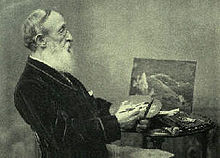art.wikisort.org - Artist
Benjamin Champney (November 20, 1817[1] – December 11, 1907) was a painter known for his role in White Mountain art of the 19th century. He began his training as a lithographer under celebrated marine artist Fitz Henry Lane at Pendleton's Lithography shop in Boston. Most art historians consider him the founder of the "North Conway Colony" of painters who came to North Conway, New Hampshire and the surrounding area during the second half of the 19th century. His paintings were often used to make chromolithographs that were subsequently sold to tourists who could not afford Champney's originals. He exhibited regularly at the Boston Athenæum and was a founder of the Boston Art Club.
This article includes a list of general references, but it lacks sufficient corresponding inline citations. (August 2019) |
Early life
Champney was born in New Ipswich, New Hampshire.[2] He first visited Conway in 1838. In 1841, Champney went to France to study, returning to Boston in 1846, and then returned to Europe almost at once to paint a panorama of the Rhine River. He returned to Boston in 1848 and exhibited the panorama there in December. It was subsequently exhibited in Worcester, Massachusetts, New Haven, Connecticut, and New York City. In 1854, he went on a painting trip to Germany and Switzerland with John Frederick Kensett. The panorama, unfortunately, was destroyed by fire in New York City in October 1857.
Allure of North Conway
In 1850, Champney returned to the White Mountains with his friend, Kensett. Their enthusiasm and paintings drew large numbers of Boston and New York artists to the Conway area. In 1853, Champney married and bought a house between Conway and North Conway. It would be his summer home for over fifty years. His studio was a noted social center, and was visited by many people from all parts of the country.
In 1855, Champney became a founder of the Boston Art Club, and, in 1856, its president.
On August 4, 1888, The White Mountain Echo reported: "Champney's studio is as much visited as ever this summer, and there are many new pictures to see. Of the landscapes, there is a view from the new carriage road up Humphrey's Ledge that is beautiful, and another a scene in Crawford Notch, and still another, a picture of Mount Chocorua from Tamworth; there are some lovely new flower pieces ... But perhaps the very prettiest is the old-fashioned pitcher in the kitchen window ..."
Later life and legacy
In 1900, he published an autobiography, Sixty Years' Memories of Art and Artists.[1]
Champney died at his home in Woburn, Massachusetts, on December 11, 1907.[3]
Examples of his paintings can be viewed today at the New Hampshire Historical Society[4] in Concord, New Hampshire; the Currier Museum of Art[5] in Manchester, New Hampshire; at Woburn Public Library in Woburn, Massachusetts; and the Museum of the White Mountains[6] at Plymouth State University in Plymouth, New Hampshire.
In recognition of his unique and lasting contribution to the arts and culture of Boston, a gaslit cobblestone alley, Champney Place, is named in his honor in historic Beacon Hill, Boston.[citation needed] He is mentioned on a New Hampshire historical marker (number 38) along New Hampshire Route 16 in Conway.[7]
Image gallery
 Advertisement for exhibition of works by Champney at Horticultural Hall, School Street, Boston, 1849
Advertisement for exhibition of works by Champney at Horticultural Hall, School Street, Boston, 1849- Saco River, North Conway
- Winter Scene, North Moat Mountain, New Hampshire, 1873
- Moat Mountain from Walker's Pond, New Hampshire, 1878
- Autumn Landscape, 1867
A typical early painting by Champney  Mount Chocorua, New Hampshire, 1858
Mount Chocorua, New Hampshire, 1858
Sources
- Beauty Caught and Kept: Benjamin Champney in the White Mountains. Historical New Hampshire, Vol. 51, Nos. 3&4, Fall/Winter 1996.
- Campbell, Catherine H. New Hampshire Scenery, Canaan, NH: Phoenix Publishing, 1985.
- Champney, Benjamin. Sixty Years' Memories of Art and Artists, Woburn, MA: Wallace & Andrews, 1900.
References
- Champney (1900)
- The National Cyclopaedia of American Biography. Vol. IV. James T. White & Company. 1893. pp. 289–290. Retrieved December 5, 2020 – via Google Books.
- "Famous Artist Gone". The Boston Globe. Woburn, Massachusetts. December 12, 1907. p. 16. Retrieved December 5, 2020 – via Newspapers.com.
- Saco River, North Conway
- Picnic on Artists Ledge
- "Mt Washington from Sunset Hill"
- "List of Markers by Marker Number" (PDF). nh.gov. New Hampshire Division of Historical Resources. November 2, 2018. Retrieved July 5, 2019.
External links
| Wikimedia Commons has media related to Benjamin Champney. |
- WorldCat
- White Mountain paintings by Benjamin Champney
- . Encyclopedia Americana. 1920.
- Benjamin Champney at Find a Grave
На других языках
- [en] Benjamin Champney
[it] Benjamin Champney
Benjamin Champney (New Ipswich, 20 novembre 1817 – Woburn, 11 dicembre 1907) è stato un pittore e litografo statunitense. Pittore paesaggista, si dedicò in prevalenza ai paesaggi di montagna.Другой контент может иметь иную лицензию. Перед использованием материалов сайта WikiSort.org внимательно изучите правила лицензирования конкретных элементов наполнения сайта.
WikiSort.org - проект по пересортировке и дополнению контента Википедии






